Bubble hash, terp sugar, crumble… the options are nearly endless and the terminology can be confusing.
Cannabis concentrates achieve greater potency and flavor with manufacturing processes that strip the terpenes and cannabinoids from the cannabis flower to create a highly “concentrated” product. This idea is not new. Hash, a form of concentrate, has been around as long as cannabis. However, over the years, many advanced techniques have evolved to create cannabis concentrates.
Just as the name suggests, cannabis concentrates are extremely concentrated; meaning that they’re potent and can leave even the most experienced smokers coughing. Needless to say, concentrates are a fairly quick and easy way to feel the immediate effects of strain-specific weed, but if searching through our concentrates menu leaves you scratching your head wondering what shatter is, and how it’s different from live rosin, keep reading!
What are Concentrates?
As mentioned, cannabis concentrates are nothing new; actually, they’ve been around for decades, first gaining initial popularity in the 1970’s — though the research behind concentrates and dabbing first began as recently as the 1940’s. Keep in mind that we’re not including hash in this brief history of concentrates, but we will give hash a well-deserved mention a bit later on.
It’s true that concentrates encompass a relatively broad variety, and they can be found anywhere from infused pre-rolls, to individually packaged glass pots, to cartridges.
By definition, concentrates are simply a collection of condensed trichomes, which happen to be the most concentrated source of THC, CBD, and terpenes contained within the marijuana plant. Because concentrates contain only the richest source of the two main components in weed, THC and terpenes, a specific strain’s flavor profile, aroma, and effects are often amplified through concentrates.
There are a variety of different concentrates to choose from ranging from badder and crumble to sauce and diamonds. While many concentrates feature their differences, many are actually the same compound, just different consistencies achieved through a specific extraction process differentiated by whether or not a solvent was used. With that being said, we’d like to begin our guide to concentrates by first highlighting a few solventless concentrates that you’ll inevitably come across on our menu.
Solventless Concentrates
Most cannabis concentrates use a solvent, which is just a compound that dissolves something else; in the case of cannabis, it’s usually butane, propane, ethanol, or CO2.
However, if you appreciate a more natural approach to your consumption, solventless concentrates are widely available on the market; the most common include hash (historically known as hashish)/bubble hash and rosin. Note that while some brands have successfully been able to create budder/badder/batter without using a solvent, most do need some sort of solvent to create these consistencies.
Hash
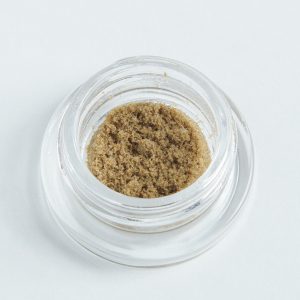
Remember how we said that hash will get its well-deserved mention in this blog post? Well, the time has come. Unlike other concentrates and consistencies, hash is nothing new. In fact, it’s the very first solventless concentrate and dates back centuries. Hashish first originated in India and the Middle East, and has since been widely regarded for its potency and flavor profile that’s true to the flower strain it hails from.
Hash is created by separating the trichomes, or kief, from the buds either by hand on a smaller scale, mechanical sifts utilizing static electricity for a modernized approach to the original sifting method, or using ice water to create ice water hash/bubble hash.
Traditional hash is often found as a compressed concentrate, whereas ice water hash/bubble hash (different names used interchangeably for the same type of concentrate) is most similar to the consistency of light brown sugar.
Rosin
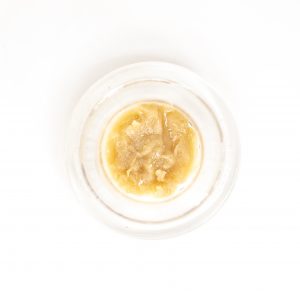
Rosin is a type of cannabis concentrate that solely relies on heat and pressure to extract the trichomes while maintaining the integrity of the plant and the terpenes. Given that no chemicals are used in the extraction process to alter the chemical composition of the concentrate, only the highest quality plant material can be used to create the highest quality rosin.
For a full breakdown of rosin and how it differs from resin, read our post, Resin vs. Rosin: What’s the Difference?
Not Solventless Concentrates
Concentrates that use a solvent to extract the trichomes are some of the most common types that you’ll see advertised on the mass market.
From shatter, to budder, to badder, to crumble, it can be easy to get lost in the terminology if you don’t have a base understanding of concentrates. So to help avoid confusion in the future, let’s begin with the most common concentrates that use a solvent extraction method: live/cured resin, crumble, sugar, sauce, tinctures, budder, badder/batter, shatter, oil, and diamonds
Whew, that’s a lot. But before you get overwhelmed, keep in mind that these ‘different’ concentrates are essentially the same, just different consistencies as achieved by different extraction methods.
Live/Cured Resin
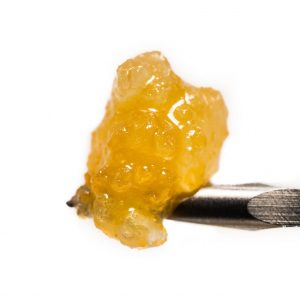
Traditional resin is not the good stuff. If you’ve read our resin vs. rosin blog, you know what we mean. To give you a quick refresher, resin was the name given to the black buildup on the inside of a bong back in the day. On the other hand, resin is often the name given to trichomes, but we won’t refer to them as such in order to avoid confusion.
However, differentiating between live/cured resin is where the real magic, and most accurate description, happens. Live resin begins with live plant matter, whereas cured resin begins with dried flower. Once again, for a full breakdown, checkout our blog linked above!
Shatter
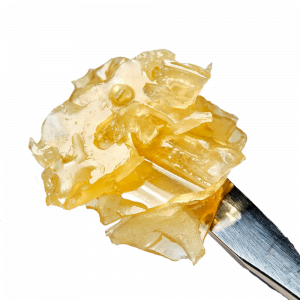
Just as its name suggests, shatter is a glass-like, brittle concentrate that’s very common in the dabbing space. More often than not, quality shatter is created with butane as the solvent used to separate the trichomes, classifying shatter as a butane hash oil (BHO) concentrate.
Shatter is often considered the purest cannabis concentrate due to its translucency and the fact that if a single step in the extraction process, or if the shatter isn’t properly stored, the consistency and integrity of the concentrate is compromised.
Crumble
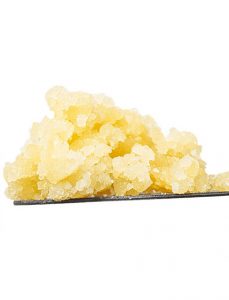
Crumble has a dry, almost powdery consistency. As you’ve probably already guessed, this cannabis concentrate crumbles easily.
Crumble has a very similar extraction process to shatter and commonly uses butane or propane as the solvent. However, crumble requires lower heat and more time compared to shatter — producing the driest concentrate consistency possible.
Sugar

If you’re looking for a concentrate that amplifies the terpenes, sugar might be for you.
As its name suggests, sugar boasts a similar consistency to, you guessed it, sugar. To be more specific, wet sugar that hasn’t been dissolved in order to maintain its semi-crystalline structure. Similar to most other concentrates, sugar has a color that lies somewhere between deep amber and bright yellow, and is defined by its consistency.
More often than not, sugar is created using butane as the solvent, commonly classifying it as a BHO concentrate.
Sauce

Tend to get lost in the sauce? It’s pretty easy to do, especially with this kind of sauce.
Sauce typically boasts a high terpene content and a liquid consistency. Potent and flavorful, sauce is easily one of the most popular cannabis concentrates, and is created by stripping the cannabis plant using solvent such as butane, propane, or CO2. Then, the chemicals are purged from the results while additional fats and lipids are removed.
Tinctures

Tinctures date back centuries as one of the earliest advancements in plant medicine. But instead of traveling by horse and buggy to your local apothecary to pick up a tincture to solve all of your problems, you hit up your local weed delivery service and find the perfect tincture to leave you feeling good for the night.
Tinctures are created by steeping, or infusing, cannabis in food-grade alcohol or oil; however, using oil as a base technically classifies the resulting product as an infusion over a tincture.
After a few days, the plant matter is strained from the tincture, leaving behind a product rich in terpenes, cannabinoids, and all the good stuff.
Budder/Badder/Batter
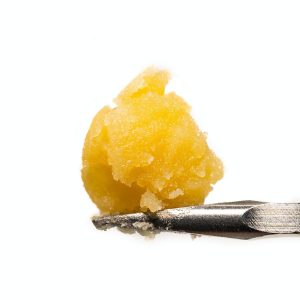
Budder, badder, batter… it’s all one in the same, right? Well, not exactly.
While most brands may use the terms interchangeably, budder is slightly different from badder/batter, though the differences are admittedly pretty minimal. In short, while budder has a consistency similar to butter (Who would have guessed?!), badder/batter (Two terms that can be used interchangeably.), has a looser, runnier consistency that’s similar to sauce.
As for the extraction process, budder and badder/batter start off fairly similar with the main difference lying in the post-extraction process and whether more or less heat and pressure are used to ultimately differentiate between the two.
Oil

THC oil is exactly what you’d expect — an oil that gets you high. Its created by using an extraction method to pull the cannabinoids from the plant material and then suspending the resulting material in a carrier oil.
Most of the time, you’ll find oil used in vape pods or cartridges; however, some oils with a thicker consistency, such as RSO oil, can be directly dripped onto a heated nail. Deciding between the consumption methods ultimately boils down to preference and whether you’d prefer the convenience of a vape pen over the control of a dab rig.
Diamonds
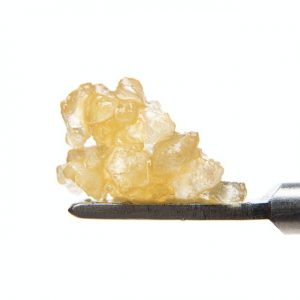
While scrolling through our dispensary menu, you’ll often see the terms, ‘liquid diamonds’ or ‘diamond-infused.’ Surely, these can’t be real diamonds, right?
Rest assured that you’re not smoking the mineral; instead, you’re smoking a stoner’s version of diamonds — cannabinoids that are purified and isolated, and under the right conditions, eventually form crystalline solids.
Our HyperWolf liquid diamonds are crafted with whole-plant cannabis; immediately frozen after harvest to retain its freshness. Then we ditched the distillate and cutting agents in favor of the real deal full of flavor— giving you the same full-spectrum experience of live resin diamonds & sauce that you’d expect from a dab rig, but in the convenience of a vape!
So, How Do You Consume Concentrates?
We’ve mentioned dabbing a few times throughout this blog because it’s a common way to smoke concentrates. Dabbing is the process of vaporizing a concentrate over a heated nail in order to inhale. While it offers total control over how much product you’re consuming, it’s not for the inexperienced smoker because it can result in a major fit of coughing and a heavy high if you’re not too careful.
Other than dabbing, concentrates can be experienced through vape pens, tinctures, edibles, and infused pre-rolls.
Do Concentrates Expire?
Thankfully, concentrates have a fairly long shelf life; meaning, that they don’t expire shortly, or even relatively soon, after purchasing. For more information, check out our blog that answers the question, “Does Weed Expire?”
So there you have it… HyperWolf’s Guide to Concentrates. Now all that’s left for you to do is try one out for yourself by placing an order for weed delivery on hyperwolf.com and letting us know what you think!

 Rewards
Rewards




